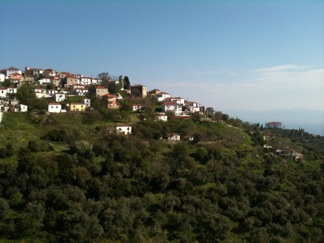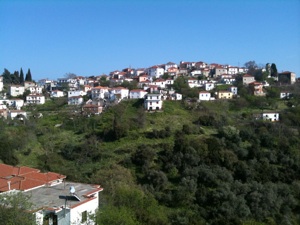Trikeri used to be an island: in fact, the island off the coast of this tip of Pelion is still known as “Old Trikeri”. The locals kept being attacked by marauding pirates, so they decided to move to the highest point of the mainland opposite, designing their village along the lines of a disorientating labyrinth, so that, should it be attacked, the perpetrators would find themselves lost and trapped and unable to escape quickly without being caught first. Please do not worry! We have not chosen Trikeri as a place to trap our friends and family (although it’s not a bad idea!), but a day getting lost in the village is definitely a suggested activity...
The name “Trikeri” is an abbreviation of “Tria Keri” which translates as Three Candles – a reference to the Holy Trinity. The Greek Orthodox Church is nearly all about the Holy Trinity and doing everything three times – for instance, you always cross yourself three times using three fingers (see our wedding ceremony page). Some bone relics of the founding fathers of Trikeri are housed in a glass cabinet inside the Church of Agia Triada, along with the top half of one of Napoleon’s thrones: rather random we know, and makes the Church sound slightly like a cabinet of curiosities (which is often the best way to think of churches anyway!)
Trikeri itself was not accessible by car until the 1980’s and, other than on a mini-ring road, it is still car-free. Access was restricted to pedestrians and mules, and even today mules are the “normal” heavy goods vehicles.
The village, the island and Agia Kyriaki, as well as the neighbouring hamlets, collectively have about 1900 inhabitants, although this number can double during the summer months, as many Greeks (mostly from Volos) have summer homes here. The locals are friendly: the men tend to work either in fishing, shipping or construction, while the women are mothers/wives and shopkeepers. During the day you’ll usually see the old men sitting in coffee shops talking politics or gossiping and the old women looking like black crones wondering around with bundles of wood or plastic bags, dodging the plethora of stray cats and dogs.
There are two tavernas (one in the main square where we are having our wedding celebration) and one just outside on the road to Milos / Agia Kyriaki, as well as a couple of bars and coffee shops where you can drink ouzo (aka tsipouro) and eat mezedes (the Greek form of tapas, small vinegary, cheese or fish dishes that accompany ouzo).
There are a couple of small grocery shops in Trikeri and one pharmacy (the opening hours of which we still haven’t quite figured out). Apparently there’s a doctor somewhere too. But there are no tourist-type shops, nowhere to buy postcards or beach towels (this must all be done in Milina). Although both Trikeri and Agia Kyriaki have a public wifi, it’s hit and miss as to whether it’s working. And hardly anyone speaks English. But we’re not trying to put you off! Think of it as an remote, unspoilt part of the world where time ticks slightly differently, and where welcoming locals view visitors as items of interest and entertainment.
Some info on Trikeri and surrounding walks: trikeri-info.jpg
For more information see http://issuu.com/lefteris_arch/docs/trikeriisland




